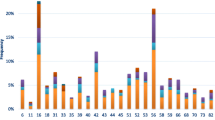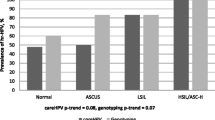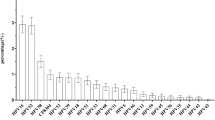Abstract
Purpose
To estimate the burden of human papillomavirus (HPV) infection among sexually active women in China.
Methods
We conducted a multi-center, population-based study between May 2006 and April 2007. A total of 4,215 women aged 17–54 years were surveyed from five geographical sites: Beijing, Shanghai, Shanxi, Henan, and Xinjiang. Direct endocervical exfoliated cells were collected from consenting participants for Sure Path liquid-based cytology (BD) and HPV testing. HPV testing was performed with Hybrid Capture II (Qiagen) with high-risk and low-risk probes, and Linear Array (Roche) was utilized for HPV genotyping.
Results
Approximately 11 % of the study population had a cytological abnormality (ASCUS or worse). HPV prevalence in the entire study population was 14.3 % (age-standardized to the world standard female population 14.5 %). The most prevalent types found were HPV16 (2.9 %), HPV52 (1.7 %), HPV58 (1.5 %), HPV33 (1 %), and HPV18 (0.8 %). Patterns of HPV prevalence differed by age, geographic region, and cytology findings. However, HPV16 was predominant among all grades of cytological abnormalities for all areas.
Conclusions
Although HPV18 appeared to be less frequent among population-based samples of China, given the high prevalence of HPV 16 and 18 in high-grade squamous intraepithelial lesion (HSIL) or worse pap abnormalities, prophylactic HPV16/18 vaccines should substantially reduce the burden of cervical cancer in China.




Similar content being viewed by others
References
Ferlay J, Shin HR, Bray F, Forman D, Mathers C, Parkin DM (2010) Estimates of worldwide burden of cancer in 2008: GLOBOCAN 2008. Int J Cancer 127(12):2893. doi:10.1002/ijc.25516
Ferlay J, Shin HR, Bray F, Forman D, Mathers C and Parkin DM. (2010) GLOBOCAN 2008, Cancer incidence and mortality worldwide: IARC Cancer Base No. 10 [Internet]. Lyon, France: International Agency for Research on Cancer; 2010. Available from: http://globocan.iarc.fr
Canfell K, Shi JF, Lew JB, Walker R, Zhao FH, Simonella L, Chen JF, Legood R, Smith MA, Nickson C, Qiao YL (2011) Prevention of cervical cancer in rural China: evaluation of HPV vaccination and primary HPV screening strategies. Vaccine 29(13):2487–2494. doi:10.1016/j.vaccine.2010.12.085
Walboomers JM, Jacobs MV, Manos MM, Bosch FX, Kummer JA, Shah KV, Snijders PJ, Peto J, Meijer CJ, Munoz N (1999) Human papillomavirus is a necessary cause of invasive cervical cancer worldwide. J Pathol 189(1):12–19. doi:10.1002/(SICI)1096-9896(199909)189:1<12:AID-PATH431>3.0.CO;2-F
zur Hausen H (1999) Papillomaviruses in human cancers. Proc Assoc Am Phys 111(6):581–587
Bioscience Division, Los Alamos National Laboratory, the Regents of the University of California. HPV sequence database: PV types and hosts _database online Available at: http://hpv-web.lanl.gov/stdgen/virus/cgi-bin/hpv_organisms.cgi?dbname_hpv Accessed August 23, 2004
de Villiers EM, Fauquet C, Broker TR, Bernard HU, zur Hausen H (2004) Classification of papillomaviruses. Virology 324(1):17–27. doi:10.1016/j.virol.2004.03.033
Munoz N, Bosch FX, de Sanjose S, Herrero R, Castellsague X, Shah KV, Snijders PJ, Meijer CJ (2003) Epidemiologic classification of human papillomavirus types associated with cervical cancer. N Engl J Med 348(6):518–527. doi:10.1056/NEJMoa021641
Garland S, Park SN, Ngan HY, Frazer I, Tay EH, Chen CJ, Bhatla N, Pitts M, Shin HR, Konno R, Smith J, Pagliusi S, Park JS (2008) The need for public education on HPV and cervical cancer prevention in Asia. Opinions of experts at the AOGIN conference. Vaccine 26(43):5435–5440. doi:10.1016/j.vaccine.2008.07.077
Harper DM, Franco EL, Wheeler CM, Moscicki AB, Romanowski, Roteli-Martins CM, Jenkins D, Schuind A, Costa Clemens SA, Dubin G (2006) Sustained efficacy up to 4.5 years of a bivalent L1 virus-like particle vaccine against human papillomavirus types 16 and 18 follow-up from a randomised control trial. Lancet 367(9518):1247–1255
The FUTURE II Study Group (2007) Quadrivalent vaccine against human papillomavirus to prevent high-grade cervical lesions. N Engl J Med 356 (19):1915–1927. doi:10.1056/NEJMoa061741
Smith JS, Lindsay L, Hoots B, Keys J, Franceschi S, Winer R, Clifford GM (2007) Human papillomavirus type distribution in invasive cervical cancer and high-grade cervical lesions: a meta-analysis update. Int J Cancer 121(3):621–632. doi:10.1002/ijc.22527
China national cause-of-death surveys. China Cancer Database Web site. Available at http://cancernet.cicams.ac.cn/data/epi/census
Stephen AL, Thompson CH, Tattersall MH, Cossart YE, Rose BR (2000) Analysis of mutations in the URR and E6/E7 oncogenes of HPV 16 cervical cancer isolates from central China. Int J Cancer 86(5):695–701. doi:10.1002/(SICI)1097-0215(20000601)86:5<695:AID-IJC15>3.0.CO;2-C
Population Division of the Department of Economic and Social Affairs of the United Nations Secretariat (2009). World population prospects: The 2008 Revision. Highlights. New York: United Nations. Available from http://www.un.org/esa/population
Bruni L, Diaz M, Castellsague X, Ferrer E, Bosch FX, de Sanjose S (2010) Cervical human papillomavirus prevalence in 5 continents: meta-analysis of 1 million women with normal cytological findings. J Infect Dis 202(12):1789–1799. doi:10.1086/657321
Dai M, Bao YP, Li N, Clifford GM, Vaccarella S, Snijders PJ, Huang RD, Sun LX, Meijer CJ, Qiao YL, Franceschi S (2006) Human papillomavirus infection in Shanxi Province, People’s Republic of China: a population-based study. Br J Cancer 95(1):96–101. doi:10.1038/sj.bjc.6603208
Wu RF, Dai M, Qiao YL, Clifford GM, Liu ZH, Arslan A, Li N, Shi JF, Snijders PJ, Meijer CJ, Franceschi S (2007) Human papillomavirus infection in women in Shenzhen City, People’s Republic of China, a population typical of recent Chinese urbanisation. Int J Cancer 121(6):1306–1311. doi:10.1002/ijc.22726
Li LK, Dai M, Clifford GM, Yao WQ, Arslan A, Li N, Shi JF, Snijders PJ, Meijer CJ, Qiao YL, Franceschi S (2006) Human papillomavirus infection in Shenyang City, People’s Republic of China: a population-based study. Br J Cancer 95(11):1593–1597. doi:10.1038/sj.bjc.6603450
Lin M, Yang LY, Li LJ, Wu JR, Peng YP, Luo ZY (2008) Genital human papillomavirus screening by gene chip in Chinese women of Guangdong province. Aust N Z J Obstet Gynaecol 48(2):189–194. doi:10.1111/j.1479-828X.2008.00844.x
Ye J, Cheng X, Chen X, Ye F, Lu W, Xie X (2010) Prevalence and risk profile of cervical Human papillomavirus infection in Zhejiang Province, southeast China: a population-based study. Virol J 7:66. doi:10.1186/1743-422X-7-66
Munoz N, Mendez F, Posso H, Molano M, van den Brule AJ, Ronderos M, Meijer C, Munoz A (2004) Incidence, duration, and determinants of cervical human papillomavirus infection in a cohort of Colombian women with normal cytological results. J Infect Dis 190(12):2077–2087. doi:10.1086/425907
Dutra I, Santos MR, Soares M, Couto AR, Bruges-Armas M, Teixeira F, Monjardino L, Hodgson S, Bruges-Armas J (2008) Characterisation of human papillomavirus (HPV) genotypes in the Azorean population Terceira island. Infect Agent Cancer 3:6. doi:10.1186/1750-9378-3-6
Zhao R, Zhang WY, Wu MH, Zhang SW, Pan J, Zhu L, Zhang YP, Li H, Gu YS, Liu XZ (2009) Human papillomavirus infection in Beijing, People’s Republic of China: a population-based study. Br J Cancer 101(9):1635–1640. doi:10.1038/sj.bjc.6605351
Coutlee F, Gravitt P, Kornegay J, Hankins C, Richardson H, Lapointe N, Voyer H, Franco E (2002) Use of PGMY primers in L1 consensus PCR improves detection of human papillomavirus DNA in genital samples. J Clin Microbiol 40(3):902–907
Chan PK, Cheung TH, Tam AO, Lo KW, Yim SF, Yu MM, To KF, Wong YF, Cheung JL, Chan DP, Hui M, Ip M (2006) Biases in human papillomavirus genotype prevalence assessment associated with commonly used consensus primers. Int J Cancer 118(1):243–245. doi:10.1002/ijc.21299
de Sanjose S, Diaz M, Castellsague X, Clifford G, Bruni L, Munoz N, Bosch FX (2007) Worldwide prevalence and genotype distribution of cervical human papillomavirus DNA in women with normal cytology: a meta-analysis. Lancet Infect Dis 7(7):453–459. doi:10.1016/S1473-3099(07)70158-5
Herrero R, Castle PE, Schiffman M, Bratti MC, Hildesheim A, Morales J, Alfaro M, Sherman ME, Wacholder S, Chen S, Rodriguez AC, Burk RD (2005) Epidemiologic profile of type-specific human papillomavirus infection and cervical neoplasia in Guanacaste Costa Rica. J Infect Dis 191(11):1796–1807. doi:10.1086/428850
Cuschieri KS, Cubie HA, Whitley MW, Seagar AL, Arends MJ, Moore C, Gilkisson G, McGoogan E (2004) Multiple high risk HPV infections are common in cervical neoplasia and young women in a cervical screening population. J Clin Pathol 57(1):68–72
Conflict of interest
This work is funded by Merck Sharp and Dohme. Currently, Kai-Li Liaw and Christine Velicer are employees of Merck Sharp and Dohme.
Author information
Authors and Affiliations
Corresponding author
Additional information
En-Qi Wu and Bin Liu have equal contribution to this work.
Rights and permissions
About this article
Cite this article
Wu, EQ., Liu, B., Cui, JF. et al. Prevalence of type-specific human papillomavirus and pap results in Chinese women: a multi-center, population-based cross-sectional study. Cancer Causes Control 24, 795–803 (2013). https://doi.org/10.1007/s10552-013-0162-8
Received:
Accepted:
Published:
Issue Date:
DOI: https://doi.org/10.1007/s10552-013-0162-8




